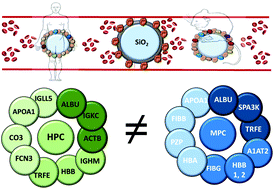A comparison of the human and mouse protein corona profiles of functionalized SiO2 nanocarriers†
Abstract
Nanoparticles are a promising cancer therapy for their use as drug carriers given their versatile functionalization with polyethylene glycol and proteins that can be recognized by overexpressed receptors in tumor cells. However, it has been suggested that in biological fluids, proteins cover nanoparticles, which gives the proteins a biological identity that could be responsible for unexpected biological responses: the so-called protein corona. A relevant biological event that is usually ignored in protein-corona formation is the interspecies differences in protein binding, which can be involved in the discrepancies observed in preclinical studies and the nanoparticle safety and efficiency. Hence, the aim of this study was to determine the differences between human and mouse plasma protein corona profiles in an active therapy model using silicon dioxide nanoparticles (SiO2 nanoparticles) functionalized with polyethylene glycol and transferrin. Functionalized SiO2 nanoparticles were made with a primary particle size of 25 nm and a transferrin content of 50 μg mg−1 of nanoparticles and were PEGylated with a cross-linker. The proteomic analysis by nanoliquid chromatography tandem-mass spectrometry (nanoLC-MS/MS) showed interspecies differences. The most abundant proteins found in the human protein corona profile were immunoglobulins, actin cytoplasmic 1, hemoglobin subunit beta, serotransferrin, ficolin-3, complement C3, and apolipoprotein A-1. Meanwhile, the mouse protein corona adsorbed the serine protease inhibitor A3K, serotransferrin, alpha-1-antitrypsin 1–2, hemoglobin subunit beta, and fibrinogen gamma and beta chains. These protein-corona profile differences in the functionalized SiO2 nanoparticles indicate that biological responses observed in in vivo models could not be translated to clinical use and must be considered in the interpretation of preclinical trials in order to design more efficient and safer nanomedicines.



 Please wait while we load your content...
Please wait while we load your content...